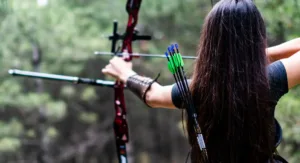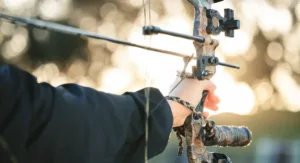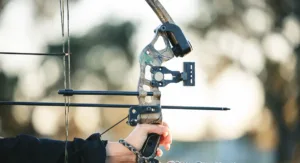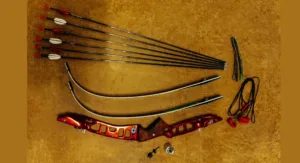Archery, a sport steeped in tradition and dating back centuries, has seen a revival. With film sagas such as “The Hunger Games” and “Arrow” glorifying the skill, many new enthusiasts are stepping into archery. However, elegance and finesse in this art of bow and arrow require practice and a sound understanding of archery terminology. For beginners, these ten archery terms form the foundational lexicon for a rewarding start to this ancient discipline.
Understanding Archery’s Essence
Before you can nock an arrow or draw a bow, it’s essential to know what archery is all about.
Archery – More than a hobby
Archery is a sport as old as human civilization itself, primarily used for hunting and combat. Today, it’s a precision sport in the Olympics and a recreational activity for many. The elegance of a well-aimed shot is matched only by the thrill of hitting a bullseye.
The Archery Terms You Need to Know
1. Nock – The Beginning of a Shot
“Nocking an arrow” refers to placing the arrow on the bowstring. Learning to nock correctly ensures the arrow stays in place and sets the stage for a smooth shot and consistent release. Beginners should focus on securing the arrow to the string precisely, as this affects the shot fundamentally.
2. Draw Weight – Bow Resistance
Draw weight measures the amount of force required to draw the string back. This is a critical factor for beginners, as a bow with too high a draw weight can lead to bad form and injury. A bow’s draw weight should be comfortable enough for the archer to draw the string smoothly and evenly.
3. Anchor Point – Consistent Form is Key
The anchor point is where the archer puts his hand during a full draw. It serves as a reference point for the archer, ensuring a consistent frame for each shot. An unchanging anchor point is crucial for accuracy as well as muscle memory.
4. Fletching – The Arrows’ Steering
Fletching consists of feathers or plastic vanes at the back of the arrow. It’s a critical part of arrow stabilization and ensures straight and accurate flight. For a beginner, understanding fletching and its influence on arrow trajectory is essential to shoot straight.
5. Bow Sights – Looking for the bullseye
A bow sight is a device fitted to the bow that aids in aiming. It can be as simple as a pin or as complex as a multi-pin sight with distance adjustments. For beginners, a bow sight can greatly improve accuracy by providing a consistent point of aim.
6. Quiver – Always Have an Arrow
A quiver is a container for holding arrows, typically secured to the bow, the body, or the ground. The type of quiver used varies depending on archery style, environment, and personal preference. Without a quiver, managing and accessing arrows becomes challenging.
7. Release Aid – Aiming for Smoothness
A release aid is a mechanical device that assists archers in releasing the bowstring with precision and smoothness. Beginners often find that using a release aid can help eliminate erratic arrow flight caused by poor hand release techniques.
Also Read : A Comprehensive Guide Of Archery Thumb Release
8. Backstop – Safe Practice Sessions
A backstop is a safety feature used to stop arrows’ trajectories, preventing overshooting. This concept is crucial, especially for archers practicing indoors or in confined spaces. A proper backstop can create a safer archery practice environment.
9. 3D Target – Aiming for Realistic Practice
3D targets are life-sized models of animals or other targets. It provides a more realistic and engaging practice experience than traditional flat targets. It helps archers handle various shooting angles and improve hunting and competitive skills.
10. Tiller – Balancing the bow
When a beginner advances, it is important to learn about the tiller concept and fine-tune their equipment so that they can get a smoother shot and ensure their arrow travels straight.
The Rewards of Understanding Archery Terminology
Archery terminology might seem specific and technical to newcomers, but each of these ten terms provides knowledge essential to enjoying and excelling in the sport. By grasping these terms, beginners lay a foundation that promotes safety, skill development, and increased enjoyment of the sport. It’s through understanding the intricacies behind a seemingly simple shot that archery enthusiasts, all distinct and old, truly appreciate the art form.
Whether you’re shooting in the backyard, at a local range, or aiming for the Olympic Games, these archery terms are the beginning of a long and rewarding adventure in the sport. Don’t just shoot, learn the art. Because archery precision is matched by knowledge.
Recent Posts
- The Ultimate Guide To Choosing Between Compound Bow vs Crossbow
- How To Carry A Bow – Tips & Techniques For Archers
- Ultimate Guide To Installing Compound Bow Arrow Rest
- The Ultimate Guide To The Best Archery Brands Of Compound Bows
- How To Utilize Recurve Bow Sights: A Comprehensive Guide
- The Archer’s Craft: Understanding Parts Of Recurve Bow







